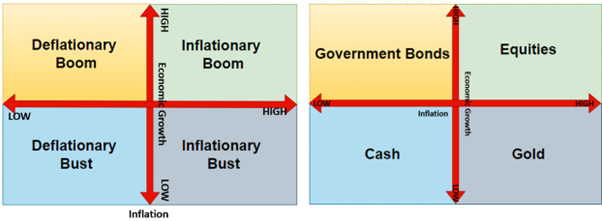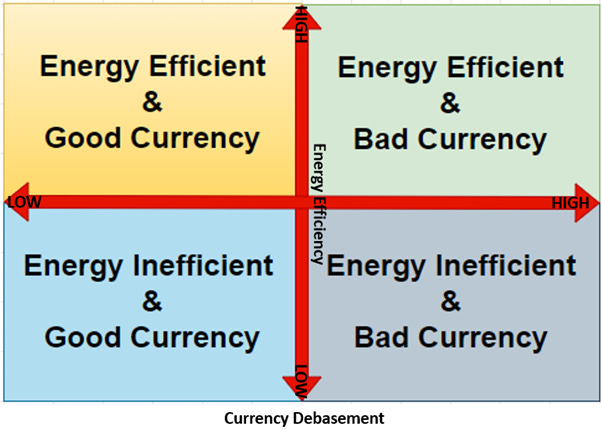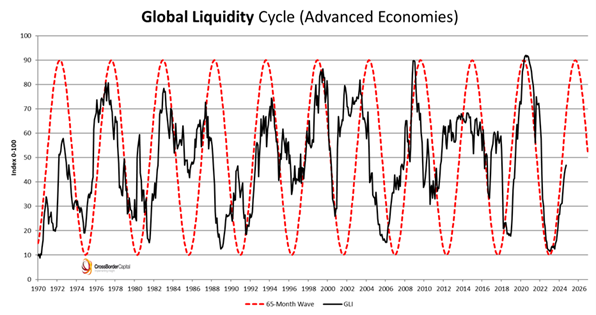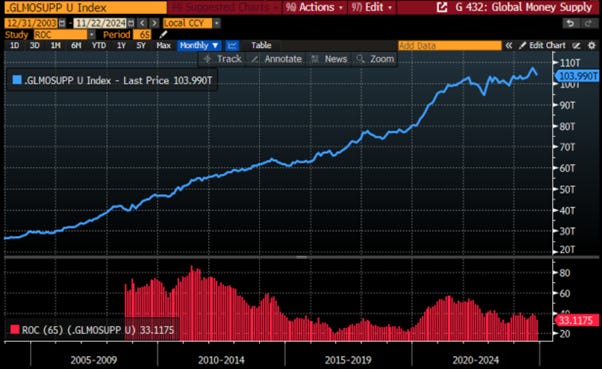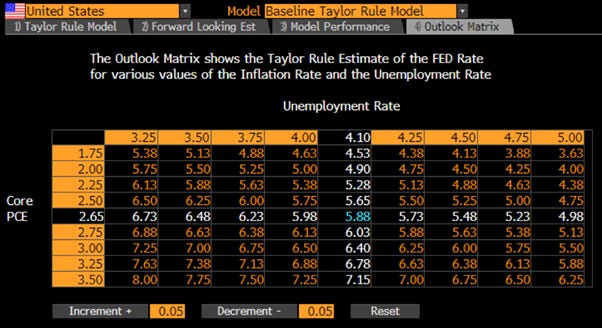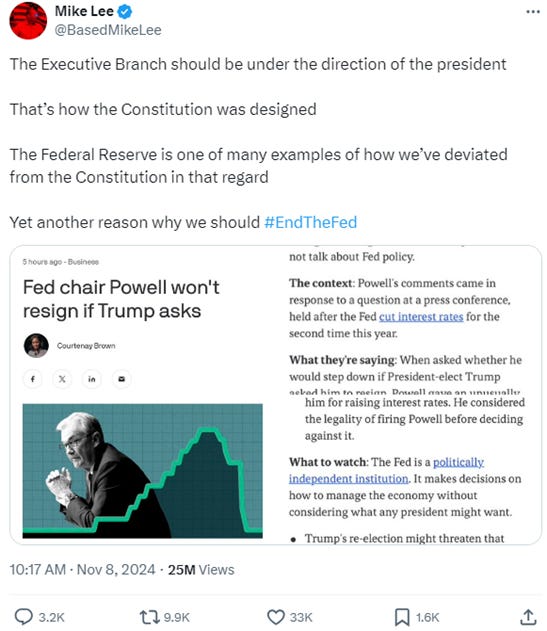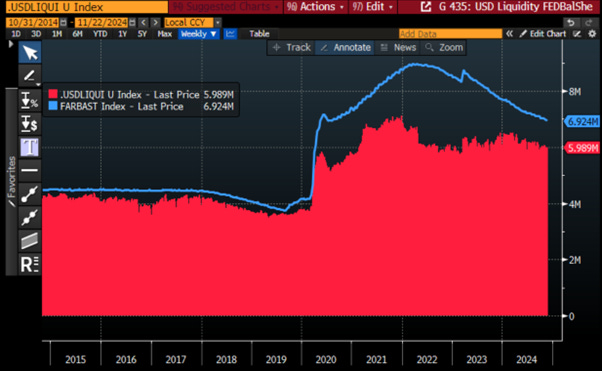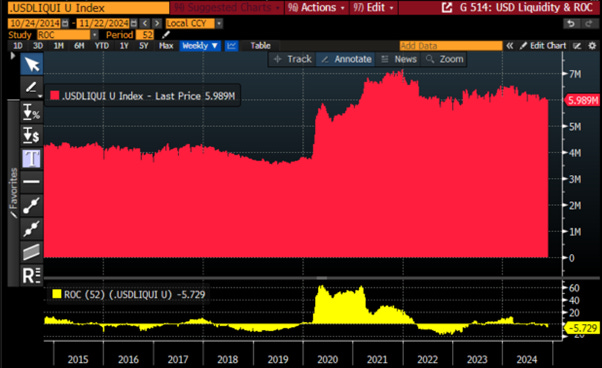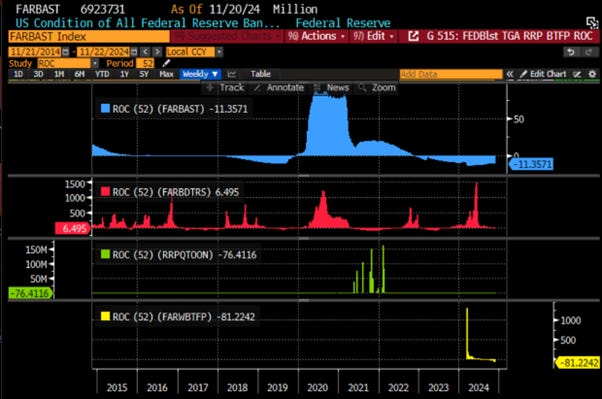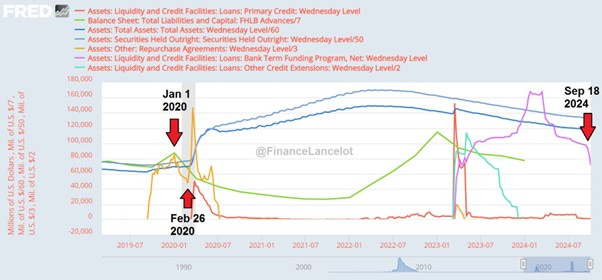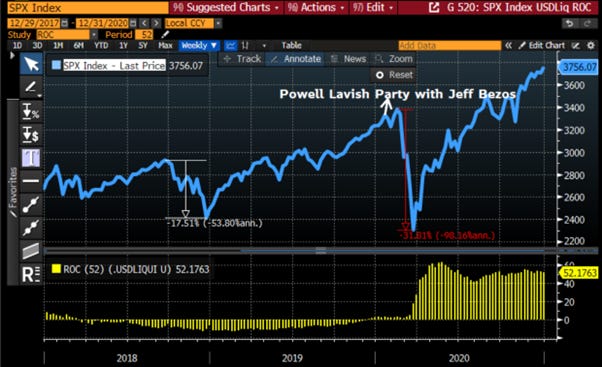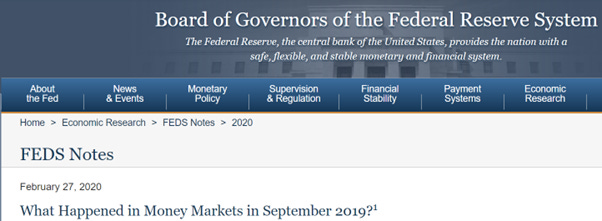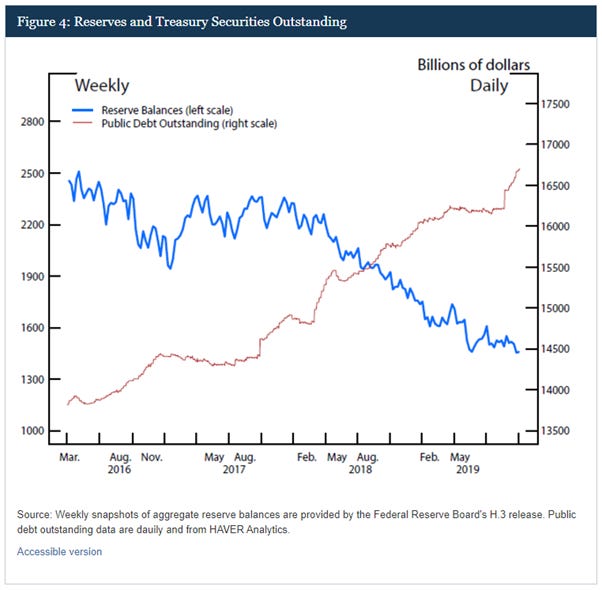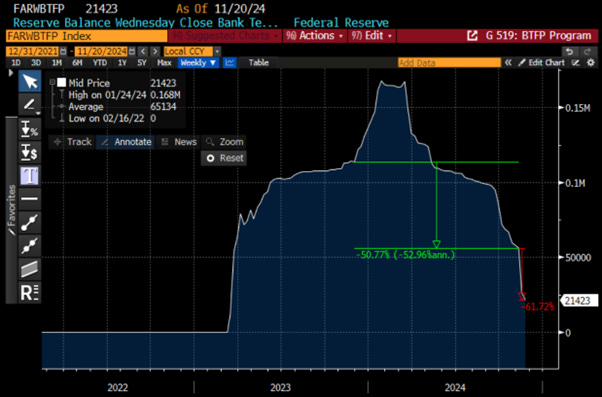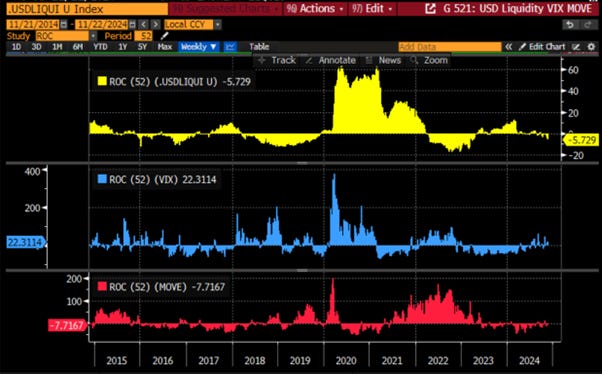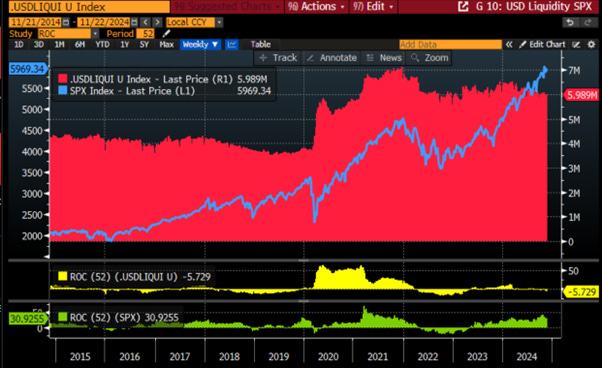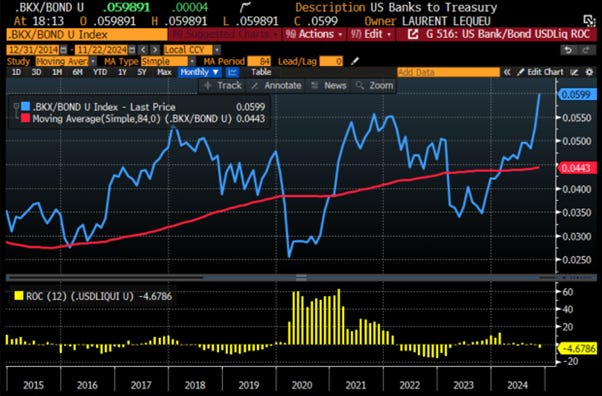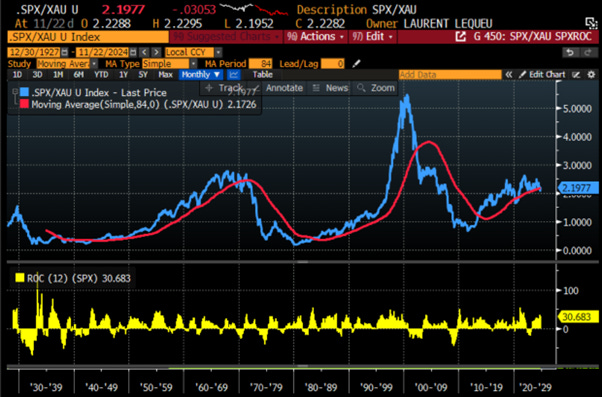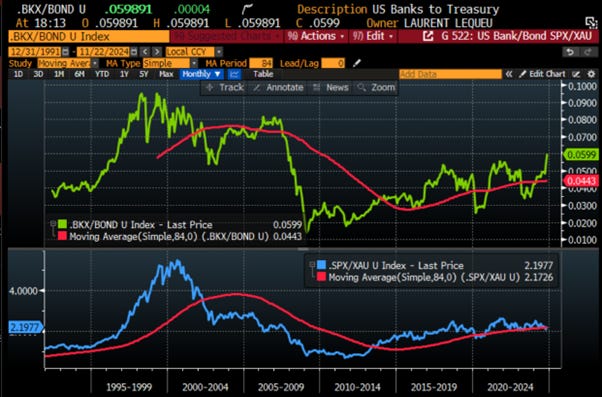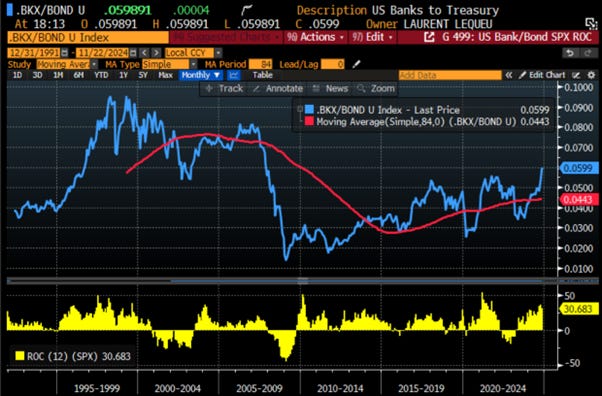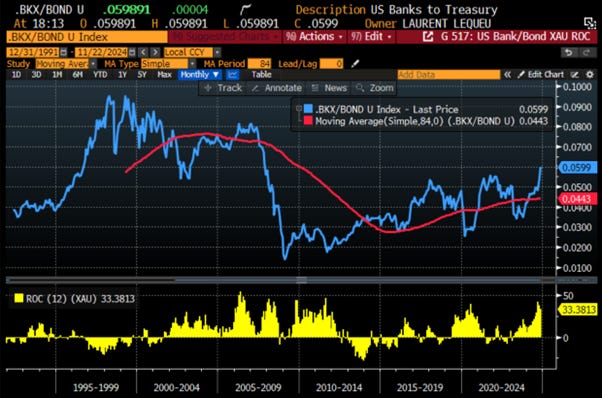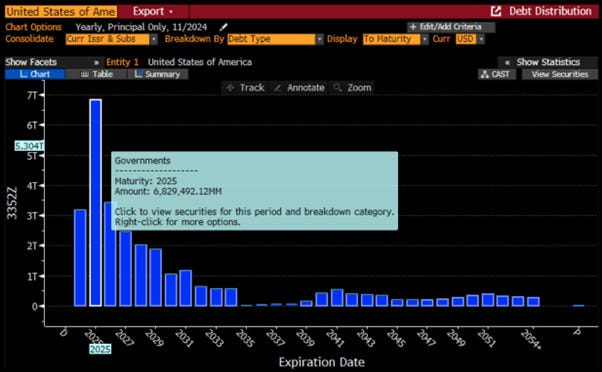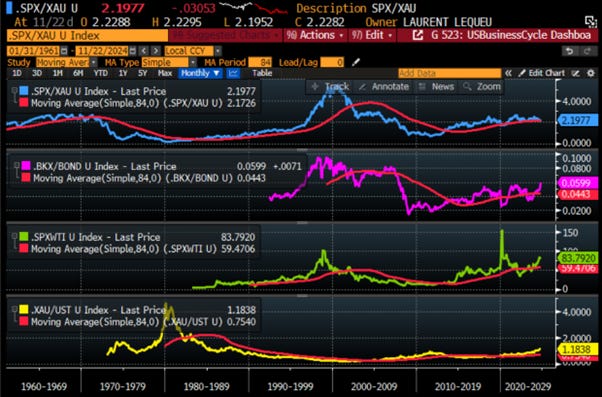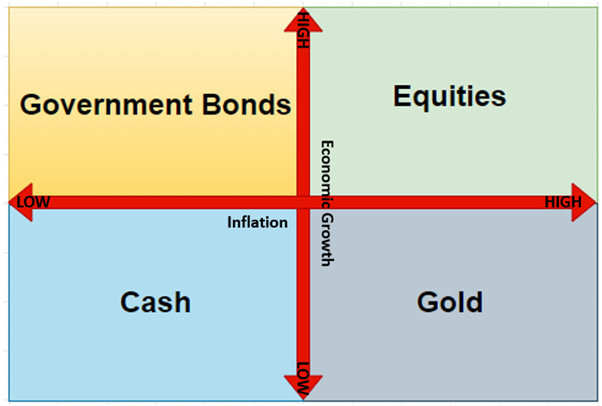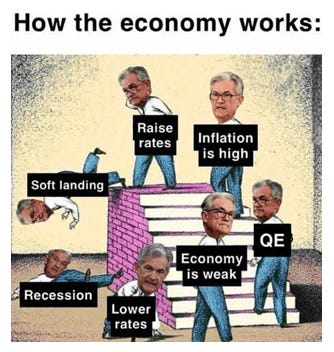Will Liquidity Be Weaponized?
Investors should by now understand that the performance of their portfolios is influenced by the state of the business cycle and how they position their portfolios to benefit from it by allocating across the four asset classes of the Permanent Browne Portfolio. As previously demonstrated, during peacetime, passive investors can simply allocate a quarter of their portfolio to each of the four asset classes in the Browne Portfolio and achieve an average annualized real return (above inflation) of 3% to 4% over the long term.
Active investors, on the other hand, can actively manage their asset allocations according to the state of the business cycle across the four asset classes, potentially delivering additional performance beyond the 3% to 4% annualized real return.
As a reminder, each phase of the business cycle favours a specific asset class:
Contracts (government bonds and cash) are the preferred assets during a deflationary boom and bust, respectively.
Properties (equities and physical gold) are favoured during an inflationary boom and bust, respectively.
Investors should by now also understand that the state of the business cycle is better gauged by the behaviour of market indicators rather than by economic data released by governments as governments have without doubts an interest in crafting narratives to lure investors, who are ultimately voters, into a propagandistic storyline that serves the ruling class, whether in a democracy, a republic, or a more authoritarian regime.
In this context, the state of an economy's growth can be assessed by its energy efficiency, which is reflected in the ability of its listed companies to create value while managing the energy prices they face in running their businesses. An economy is considered to be in a boom phase if the ratio of its equity market to oil prices is above its seven-year moving average, whereas it is in a bust phase if this ratio falls below the seven-year moving average.
On the other axis of the quadrant, the state of inflation in an economy can be assessed by determining whether the domestic bond market serves as a reliable store of value compared to the ultimate and ancestral store of value: physical gold. By calculating the ratio between the price of gold in fiat currency and the total return of the government bond index and compare it against its 7-year moving average, we can evaluate fiat currency debasement. If the ratio is below its seven-year moving average, the bond market has been functioning as a proper store of value, indicating that the economy is likely experiencing a deflationary environment. Conversely, if the ratio is above its seven-year moving average, the currency is being debased, suggesting that the economy is likely experiencing an inflationary environment.
Therefore, any economy in question can be in one of the following four states:
Energy inefficient/good currency equates to a deflationary bust.
Energy efficient/good currency equates to a deflationary boom.
Energy efficient/bad currency equates to an inflationary boom.
Energy inefficient/bad currency equates to an inflationary bust.
Those familiar with the ‘Browne portfolio’ will remember that the best asset among the four components of the Permanent Portfolio to own in an energy-efficient economy with a bad currency is equities. Equities thrive in such an environment, as they benefit during periods of prosperity and economic expansion. This is probably why the US equity market have been making new all-time highs over the past quarters.
Outside the state of the business cycle, which is by essence moving slowly, the performance of financial assets is driven by the liquidity cycle. Liquidity, like the economy, is cyclical. Global Liquidity can be measured as a normalized index (GLI) ranging from 0 to 100, with a mean of 50, to track its momentum over time and across countries. A chart plotting the GLI against a repeating 65-month cycle (estimated using Fourier analysis from 1965-2000 and extrapolated since), shows that the Global Liquidity Cycle is expected to peak around September 2025, following the trough in December 2022.
A look at a proxy for global money supply, calculated by summing up the M2 of major economies such as the United States, the Eurozone, China, Japan, South Korea, Canada, Taiwan, Brazil, Switzerland, Australia, Mexico, and the UK, reveals that the 65-month rate of change for this indicator appears to have already peaked in September 2024.
Global Money Supply Proxy (blue line); 65-months Rate of Change (red histogram).
It is widely recognized that the economy, and ultimately the business cycle, has been subject to manipulation. Some economists, particularly those aligned with the Keynesian approach to economic management, believe they can distort the business cycle by introducing government spending to avoid the natural transition from an economic boom to a bust. These same ‘financial alchemists’ have not only weaponized the economy and financial markets by implementing regulations designed to benefit their plutocratic allies and maintain their power but also to manipulate election outcomes.
Focusing on the case of the United States, where actions resembling those of a banana republic are increasingly evident, it now appears crystal clear that the Federal Open Market Committee's decision to cut rates by 50 basis points on September 18th, despite the US being in an inflationary boom, was purely driven by the political partisanship of the Federal Reserve Chairman, aimed at influencing the outcome of the November 5th election. Indeed, this decision was in direct contradiction to the Taylor Rule, which has guided Federal Reserve policies for the past 50 years and at the time indicated a rate hike, as it still does today.
The FED’s recent rate cut failed to influence the ‘red wave,’ which was ‘too big to rig’, raising questions about its approach under the new US president, who will contend with FED Chair Powell until at least May 2026. At the last FOMC press conference, Powell was asked if he would resign if Trump demanded it, to which he replied, ‘No.’ When pressed on whether a president could fire or demote a FED chair, Powell stated, ‘Not permitted under the law.’ This exchange led Sen. Mike Lee (R-Utah) to post on X: ‘The Executive Branch should be under the direction of the president. That’s how the Constitution was designed. The Federal Reserve is one of many examples of how we’ve deviated from the Constitution in that regard. Yet another reason why we should #EndTheFed.’
https://x.com/BasedMikeLee/status/1854709725386121244
Beyond the dramatic childish posts on X, which may fuel day-trading volatility as the current FED Chair’s term winds down, it’s widely recognized that the FED has employed ‘stealth easing’ in recent years, spreading the illusion of tightening while injecting shadow liquidity behind the scenes. Often referred to as ‘Not QE, QE,’ or ‘shadow liquidity’ to manipulate financial markets while still preaching officially a tight monetary policy. The FED's quantitative tightening is typically discussed in terms of the absolute size of its balance sheet (blue line). However, this view is incomplete, as not all parts of the balance sheet create liquidity. The FED can inject liquidity through other mechanisms, such as the Treasury General Account (TGA), the Reverse Repo Program (RRP), or emergency measures like the 2023 Bank Term Funding Program (BTFP). These discrepancies highlight how the FED’s ‘shadow liquidity’ measures evolve during crises, significantly influencing financial markets beyond what balance sheet changes alone suggest.
FED Balance Sheet (blue line); USD Liquidity proxy Index (red histogram).
It is well understood that for the human body to remain healthy, blood must flow freely through its arteries. While the total volume of blood is critical for survival, the variation in blood supply to ensure proper functioning of all organs is equally vital. Similarly, liquidity serves as the lifeblood of an economy and financial markets. Not only does the total amount of liquidity available influence the business cycle, but fluctuations in liquidity also impact the health of an economy and its financial markets. When liquidity dries up, it can create choke points, initially in financial markets and eventually in the broader economy, triggering shifts in the business cycle. In this context, examining the 52-week rate of change in the USD Liquidity Proxy Index reveals that it is now as negative as it was during the summers of 2018 and 2022.
USD Liquidity proxy Index (red histogram); 52-week rate of change (yellow histogram).
Examining the factors behind the recent trend in the rate of change of shadow liquidity, investors can observe that the biggest contributors to this negative rate of change over the past year have been the Bank Term Funding Program (BTFP) and the increase in the Treasury General Account (TGA), which have drained liquidity from the economy and financial markets into government coffers and is under the responsibility of the Treasury secretary. Conversely, the Federal Reserve has utilized the Reverse Repo Facility to inject liquidity into bond markets, primarily to finance the issuance of Treasury bills by the US government to cover its reckless budget deficit, thereby providing shadow liquidity to financial markets.
52-week rate of change in FED balance sheet (blue histogram); Treasury General Account (red histogram); Reverse Repo Program (green histogram); Bank Term Funding Program (yellow histogram).
While some may call it a conspiracy theory, this is not the first time the FED and the government have attempted to weaponize shadow liquidity injections to advance a hidden political agenda. In January 2020, the FED reduced emergency repo operations by $110 billion (-44%) over 8 weeks.
On January 25th, 2020, Powell attended a lavish party given by Jeff Bezos which trigger a lot of discussion of the collusion between the FED chairman and the Washington plutocrats.
https://x.com/FinanceLancelot/status/1837321931227300175
This event occurred after the FED contracted USD liquidity for almost two years, which contributed to the Santa Claus crash of 2018 and preceded the Covid crash in March 2020. This was followed by a tsunami of liquidity, justified as necessary to support the US economy during the lockdown, which also triggered a surge in mail-in ballots, contributing to Joe Biden's election victory and his time in the White House over the past four years.
S&P 500 index between 29th December 2017 and 31st December 2020 (blue line); 52-week rate of change of USD liquidity proxy (yellow histogram).
To understand what caused the bank liquidity crisis in September 2018 and 2019, the FED's notes from February 2020 provide invaluable insight.
Flashing back to mid-September 2019, overnight money market rates spiked due to a large drop in reserves from corporate tax payments and increased Treasury issuance. While some rate pressure was expected, the extent of the spike and volatility was surprising. The Federal Reserve's balance sheet normalization and heavy Treasury issuance led to a decline in reserves, which fell by $120 billion over two days. This created a mismatch in the repo market, where more Treasury securities needed financing with less cash available. The FED's actions, including repo operations, addressed these pressures and stabilized rates. However, these strains were amplified by reduced reserves, increased Treasury securities, and high borrowing demand in the repo market, which led to significant rate increases. The FED’s response, including repo operations and a technical adjustment to administered rates, helped restore stability. These events highlighted how routine market factors, combined with the FED's policy decisions, can create liquidity strains in money markets.
Fast forward to the past eighteen months, the Bank Term Funding Program (BTFP), created by the Federal Reserve in March 2023 to support banks following the failures of Silicon Valley Bank and Signature Bank, ended new loans as scheduled on March 11, 2024. The closure raises concerns about banks' liquidity and their ability to meet depositors' demands. Since its inception, banks leveraged the program to borrow at low interest rates using undervalued bonds as collateral, earning a higher return by depositing the funds at the FED or even using it to trade in equity market. With the program's end, banks face increased economic strain, potentially hindering growth and stability and creating additional volatility in financial markets.
Indeed, since the announcement of the result of the 2024 US presidential election on November 6th, the BTFP has declined by over $30 billion, from more than $56 billion to just above $21 billion as of November 20th, marking, or a 62% annualized rate of decline, accelerating from the 53% annualised decline from the start of the year till November 6th.
US FED Bank Term Funding Program.
In this context, it should come as no surprise that the partisan and politically driven Federal Reserve Chairman, in a speech at the World Affairs Council in Dallas on November 15th, emphasized that the path to further rate cuts will remain not only data-dependent but also much bumpier than Wall Street expects. The Chairman comment just highlights the Federal Reserve's impotency to address higher inflation driven by war-induced shortages and tariffs on imported goods in a deindustrialized United States.
For investors, what really matters is that declining shadow liquidity in financial markets acts as a catalyst for higher volatility in both equity and bond markets.
52-week Rate of change of USD Liquidity Proxy Index (yellow histogram); Chicago Board Option Exchange Volatility Index (VIX Index) (blue histogram); Ice BofA MOVE Index (red histogram).
This ultimately leads to weaker performance in financial markets, as a negative YoY change in shadow liquidity has been associated with a negative YoY change in S&P 500 returns.
S&P 500 index (blue line); USD Liquidity Proxy Index (red histogram); 52-week rate of change in USD Liquidity Proxy index (yellow histogram); 52-week rate of change in S&P 500 index (green histogram).
Indeed, liquidity and business cycles are closely connected, with the banking system playing a key role in a country’s economic health. The banking sector, a major component of any modern economies, is part of the broader financial services industry, which also includes asset management, insurance, venture capital, and private equity. At the end of 2023, the US banking system held $23.6 trillion in assets and generated $263 billion in net income. Holding financial assets remains central to banking, a practice that dates back to ancient times when it focused on storing gold for wealthy clients.
At its core, a bank takes deposits from individuals or businesses, offering withdrawal access and sometimes interest. It then lends this money to others, earning interest from borrowers. Banks profit by charging higher interest rates on loans than they pay on deposits. By law, they must keep a portion of their capital in reserve, typically around 8% for large US banks. Beyond loans, banks can invest in assets like government securities. They are vital to the economy, providing credit for individuals and businesses to make purchases, expand, and meet payrolls. They are supposed to offer safe, insured deposits and facilitate everyday transactions through services like credit, debit, and checking accounts. The banking sector also employs millions, with nearly 2 million people working in FDIC-insured commercial banks in 2023.
The health of a banking sector's role in the economy can be assessed by comparing the market value of banks to the value of the country's bond market. Investors should track this ratio against its 7-year moving average. If the ratio is above the moving average, it signals favourable economic conditions with low borrowing costs and banks offering financial conditions leading to an economic boom. Conversely, if the ratio is below the moving average, it indicates restrictive financial conditions, likely triggering sooner rather than later to an economic bust. Historically, a negative year-on-year change in shadow liquidity can be a trigger to push the Bank-to-Bond ratio below its 7-year moving average, as seen in 2018 and 2022. With the USD liquidity proxy's 12-month rate of change turning negative in November 2024, investors should be on their toes for what comes next in 2025 for the business cycle.
Upper Panel: KBW Bank Index to US Treasury Index ratio (blue line); 84 months Moving Average of the KBW Bank Index to US Treasury Index ratio (red line); Lower Panel: 12-months rate of change of the USD liquidity proxy (yellow histogram).
Savvy investors also understand that part of an economy's performance can be driven by monetary illusion, as people perceive wealth in nominal terms (USD) rather than real terms (adjusted to gold, the ultimate store of value). To avoid the effects of monetary illusion, investors should measure the performance of financial assets in gold terms rather than nominal terms and assess their evolution against a 7-year moving average. Analysing the year-on-year change in the USD liquidity proxy index shows that negative yearly changes have historically triggered the S&P 500 to gold ratio to fall below its 7-year moving average, as seen in 2018 and 2019.
Upper Panel: S&P 500 to gold ratio (blue line); 84 months Moving Average of the S&P 500 to gold ratio (red line); Lower Panel: 12-months rate of change of the USD liquidity proxy (yellow histogram).
On that matter, investors should remember that the decline of the S&P 500 to gold ratio below its 7-year moving average has seldom been a good omen for equity investors over the past century.
Upper Panel: S&P 500 to gold ratio (blue line); 84 months Moving Average of the S&P 500 to gold ratio (red line); Lower Panel: 12-months rate of change of S&P 500 index (yellow histogram).
For those monitoring the evolution of the business cycle to allocate their portfolios across the four asset classes of the Permanent Browne Portfolio, this is particularly important. The evolution of the KBW Bank Index to US Treasury Index ratio against its 7-year moving average is closely linked to the S&P 500 Index to Gold ratio against its 7-year moving average. As many now know, the latter is the best indicator leading indicator for the evolution of the S&P500 to Oil ratio around its 7-year moving average, which is ultimately determines the energy efficiency of the US economy, which ultimately determines whether the economy is in a boom or bust phase of the business cycle and if investors must buy the dips or sell the rips in equities.
Upper Panel: KBW Bank Index to US Treasury Index ratio (green line); 84 months Moving Average of the KBW Bank Index to US Treasury Index ratio (red line); Lower Panel: S&P 500 to Gold ratio (blue line); 84 months Moving Average of the S&P 500 to Gold ratio (red line).
For the time being, while the US Bank to Bond ratio remains well above its 7-year moving average, but investors should pay close attention to the year-on-year change in the USD liquidity proxy. This could be used by those plutocrats who have weaponized the US economy under the 46th president to potentially jeopardize the incoming administration, which is expected to begin implementing its new fiscal policy by January, if no black swan events prevent them from taking power by then. Investors must understand that once the Bank to Treasury Index falls below its 7-year moving average, it has historically signalled that investors should sell the rips rather than buy the dips in equities.
Upper Panel: KBW Bank Index to US Treasury Index ratio (blue line); 84 months Moving Average of the KBW Bank Index to US Treasury Index ratio (red line); Lower Panel: S&P 500 index 12-months rate of change (yellow histogram).
The implication of an inefficient banking system also impacts the performance of gold, which, aside from being the only asset that provides a hedge against government risks, is also the only asset with no counterparty risks, thriving during banking crisis. In this regard, investors in the emerging markets have long understood the importance of not trusting either their government or their banking system but investors in the mistakenly developed world still need to understand this reality. This is why a move of the US Bank to Treasury ratio below its 7-year moving average will add an additional tailwind to the appreciation of the price of gold in USD terms.
Upper Panel: KBW Bank Index to US Treasury Index ratio (blue line); 84 months Moving Average of the KBW Bank Index to US Treasury Index ratio (red line); Lower Panel: Gold 12-months rate of change in USD terms (yellow histogram).
All this potential weaponization of liquidity is occurring as over $6.8 trillion of the $35.9 trillion in total U.S. public debt, approximately 20% of the total, matures in 2025 and will require refinancing. This will take place in an even more inflationary environment, driven by tariffs and forever bankers' wars that continue to exacerbate supply shortages.
In a nutshell, the US is still in an inflationary boom, but with the rising risk of liquidity being weaponized for a partisan politically driven agenda, the US economy could move sooner rather than later into an inflationary bust. As the 12-month rate of change in the USD liquidity proxy has turned negative, investors should be increasingly concerned that, despite expected deregulations under the 47th US president, the current inflationary boom could quickly turn into a bust if the banking system fails to operate profitably for the benefit of US citizens under tighter liquidity. Historically, negative trends in liquidity have triggered crisis in the banking system, which in turn accelerates monetary illusion and ultimately pushes the economy from a boom into a bust. Given that the S&P 500 to gold ratio is struggling to stay above its seven-year moving average, it suggests that the economy is likely to transition into an inflationary bust sooner rather than later. This impending bust will also most likely be triggered by escalating trade wars and the intensification of the kinetic conflict in the Middle East.
Combining the business cycle with the Browne Permanent Portfolio, we see that in an inflationary boom, investors should overweight equities and underweight the asset classes which are represented by contracts (like Cash and government bonds) in the portfolio, while replacing these contracts by the ultimate property which has no counterparty risk, and which cannot be confiscated: Gold.
In conclusion, as the US economy is slowly but surely shifting from an inflationary boom to an inflationary bust as weaponized liquidity could be one of the triggers for this shift. In this context, gold, not government bonds, is the antifragile asset to hold. Investors familiar with the business cycle and the Permanent Browne Portfolio understand that despite Wall Street's misleading advice to buy long-term bonds and sell gold, the opposite strategy is wise: sell rallies in fixed income and buy gold dips. As the US economy likely moves into a bust by mid of 2025, investors should also, shift from energy consumer sectors like IT to energy producers like oil and gas once the S&P 500-to-oil ratio dips below its 7-year average. This comes into an environment where investors will have to increasingly prioritize the Return OF Capital over Return ON Capital.
Read more and discover how to position your portfolio here: https://themacrobutler.substack.com/p/will-liquidity-be-weaponized
If this report has inspired you to invest in gold and silver, consider Hard Assets Alliance to buy your physical gold:
https://hardassetsalliance.com/?aff=TMB
At The Macro Butler, our mission is to leverage our macro views to provide actionable and investable recommendations to all types of investors. In this regard, we offer two types of portfolios to our paid clients.
The Macro Butler Long/Short Portfolio is a dynamic and trading portfolio designed to invest in individual securities, aligning with our strategic and tactical investment recommendations.
The Macro Butler Strategic Portfolio consists of 20 ETFs (long only) and serves as the foundation for a multi-asset portfolio that reflects our long-term macro views.
Investors interested in obtaining more information about the Macro Butler Long/Short and Strategic portfolios can contact us at info@themacrobutler.com.
Unlock Your Financial Success with the Macro Butler!
Disclaimer
The content provided in this newsletter is for general information purposes only. No information, materials, services, and other content provided in this post constitute solicitation, recommendation, endorsement or any financial, investment, or other advice.
Seek independent professional consultation in the form of legal, financial, and fiscal advice before making any investment decisions.
Always perform your own due diligence.
NEVER MISS THE NEWS THAT MATTERS MOST
ZEROHEDGE DIRECTLY TO YOUR INBOX
Receive a daily recap featuring a curated list of must-read stories.



